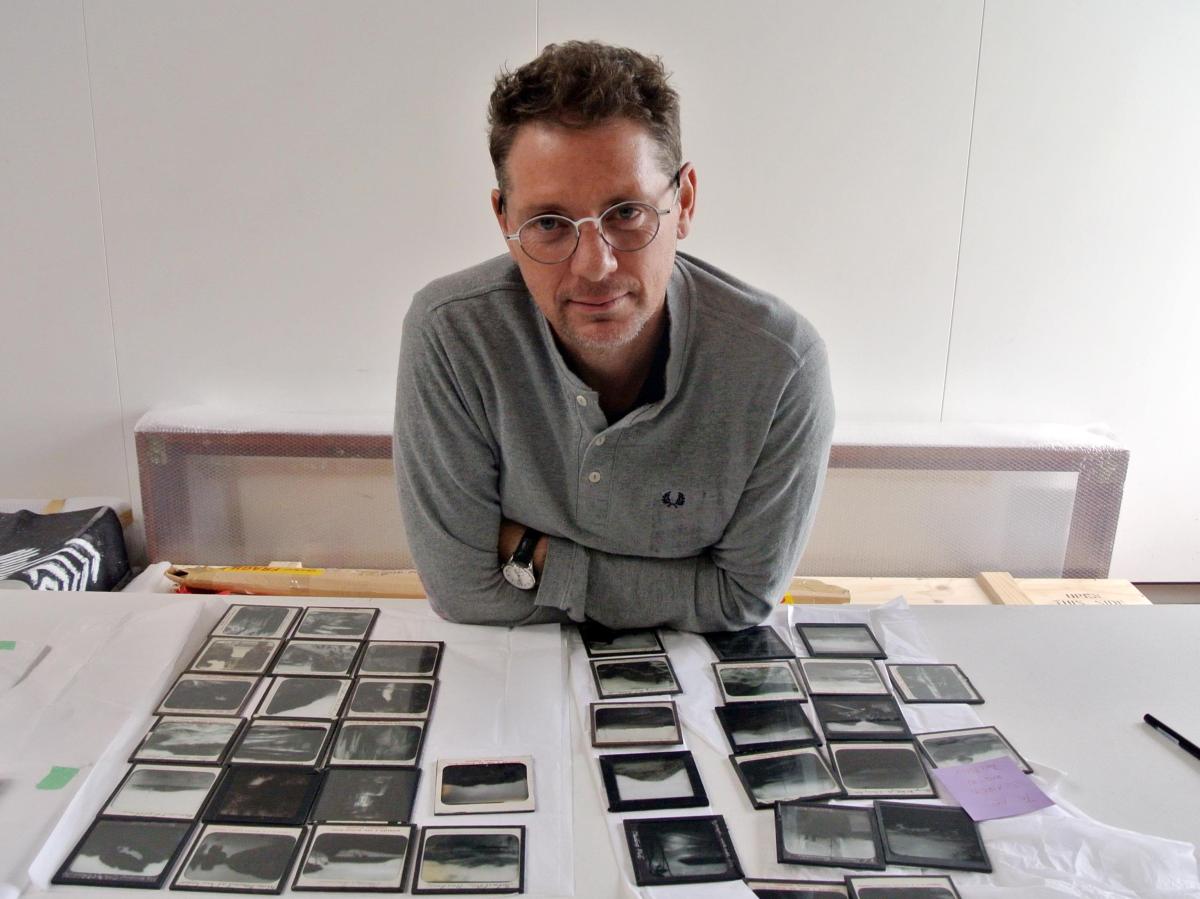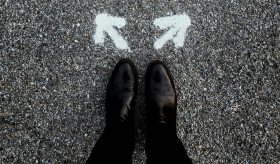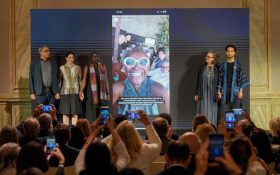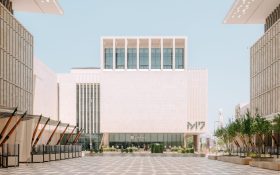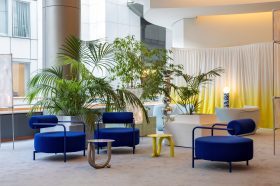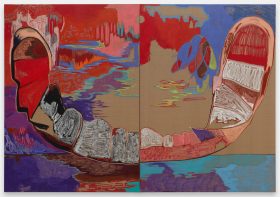Brook Andrew. Photograph Trent Walter
Brook Andrew has been named Artistic Director of the 22nd Biennale of Sydney (BoS), which will be held in 2020. He is the first Indigenous Australian artist to be offered the role with one of the world’s oldest biennales.
He told ArtsHub: ‘I think the art world has always struggled with working with creatives, artists and cultures that are not necessarily at the centre. I am interested in creating a biennale where the feeling is uniquely at the edge.’
The Sydney-born Melbourne-based artist is a self confessed “Westie” – growing up in Sydney’s western suburbs – where he said his own experience of ‘edge cultures’ and ‘alternative narratives’ will shape his 2020 exhibition.
Andrew commented that there is a lot of urgency at the moment in the world, which would have an impact on the exhibition he shaped. ‘Capitalism is falling apart, there’s what’s happening in North Korea, and what is happening here in Australia, where the denial of other existing histories is still on the cards – it is the perfect time to have a biennale.’
I am not a curator
Andrew emphatically positions himself in this appointment as an artist.
‘This is an artistic director role, and if we unpack what that term means it is not a curator – I am not a curator. It is about directing artistic movements, and I think that has more possibilities than a curator,’ he said.
Andrew added with a laugh that the opportunity, however, did not give him the license to be putting his work everywhere.
He believes that an artist in this role brings a very different position when negotiating relationships and commented that ‘the punter knows straight away when the artist has been restricted.’
Andrew’s own practice has embraced collaboration across scholarly and creative disciplines – an energy and modus operandi that his hopes to bring to the 22nd Biennale of Sydney.
‘Hopefully with that openness of collaboration there comes a generosity, which allows the artist to feel comfortable and confident. They may seem romantic values, but I get so much joy out of collaboration and, through it, grow myself,’ he told ArtsHub.
Andrew wants to introduce an Artist Hub within the exhibition – a place where artists can hang out and have the time to feel relaxed. Simply, he is keen to put the idea of community back into the biennale.
‘There are VIP rooms at art fairs … I am keen to get an Artist Hub going. There is no real authentic engagement between the artists. I understand they are all time poor – it all happens in three days – but I am really interested in people sharing knowledge in a very organic way,’ said Andrew.
He envisaged the space to additionally be activated by talks and artists collectives.
What might we expect
Andrew has a reputation for creating immersive and transformative spaces. He confirmed that we can absolutely expect to see that with the 22nd Biennale of Sydney.
In the 2010 Biennale, Andrew exhibited at the iconic venue of Cockatoo Island (he also participated in 2017); in 2015 his giant inflatable forms were presented in the Barangaroo Cutaway – a significant historical site on Sydney’s foreshore – and his 2017 survey exhibition, The Right to Offend is Sacred, demonstrated his capacity to reimagine the museum space.
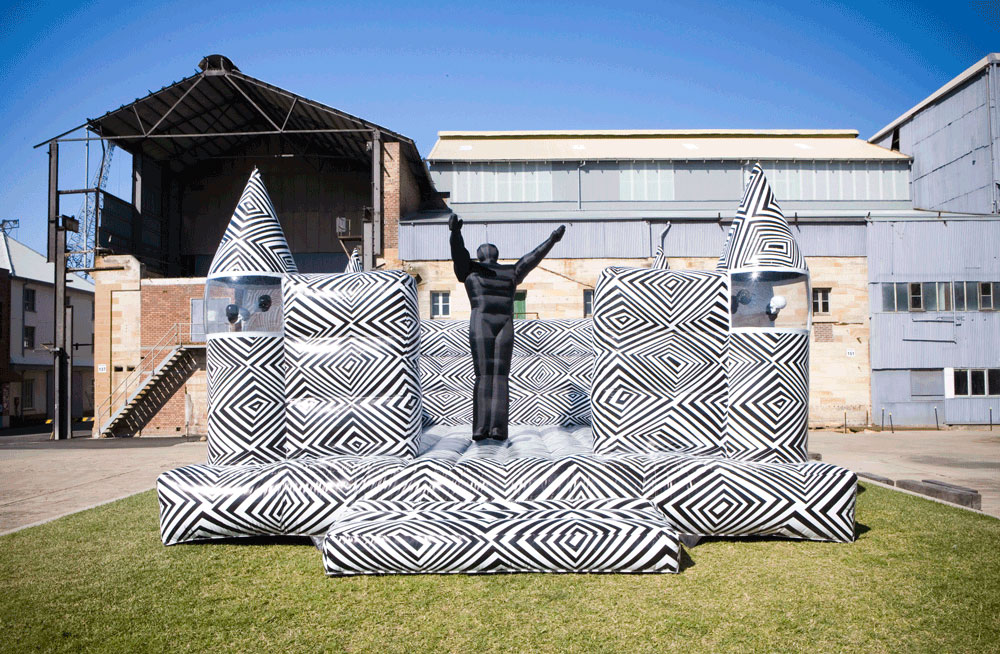
Brook Andrew, Jumping Castle War Memorial, 2010, vinyl inflatable, 400 x 700 x 700 cm. This work was made possible through the support of DETACHED, Hobart in partnership with the University of Queensland Art Museum and Urban Art Projects. Installation view of the 17th Biennale of Sydney (2010) at Cockatoo Island. Photograph: Ben Symons. Courtesy the artist and Tolarno Galleries, Melbourne
‘I really love the Barangaroo space, but I am interested in other spaces as well – both museum spaces and bespoke spaces … I am a big fan of Münster Skulptur (held every ten years in Germany). Last year you could walk into a local tattoo store and get a tattoo by (the American artist) Michael Smith. I really love that, to have the grass roots right up front and offered in alternate venues,’ he told ArtsHub.
‘It’s about how the artist would like to work with space and how I can help them augment those spaces in interesting ways.’
Andrew agreed that while Cockatoo Island was a difficult and expensive site to work with, he hopes to keep it on the table for consideration.
With regard to themes, Andrew said he is also interested in concepts such as foraged food and sculptural fashion, and the overlaps and overlays of architecture and design.
‘For example, I am interested in the histories of seed cultures, and how artists work with chefs or communities to create art works that mean something at a grass roots level, but also communicate to a well-heeled art crowd,’ he said.
‘These juxtapositions are really key, especially if the message is strong. I am hoping people might even see the artist differently.’
‘There is still that dominant narrative that comes from a particular ‘art’ view. I’m interested in that, but also how it juxtaposes next to other cultures or other ideas that are not at the centre – inverting the canon – so that the edge will become the centre,’ he told ArtsHub.
‘There are so many artists who have these practices out there but are not always supported,’ Andrew added.
Andrew said he’s less interested in the ‘usual suspects’ or ‘art stars’ or colonialist conversations that get too bogged down in ‘black and white’ politics.

Installation view Brook Andrew survey exhibition The Right to Offend is Sacred at NGV Australia; Photo ArtsHub
Finding balance in agency and issues
Social issues and agency are topics very on point in curatorial circles globally at the moment.
Andrew describes himself as ‘a very socially, politically aware artist and community member’, but warned that you have to get your historical facts right.
‘In today’s precarious society, at every point you have to get your facts right, but you also have to collaborate as there are always better ways to do something, to say something. That is an authentic experience – people who share passion – for me that is what art is,’ said Andrew.
Andrew has a strong focus on education, scholarship, and the access that people have to art.
Jo-Anne Birnie-Danzker, Director and CEO, Biennale of Sydney told Artshub: ‘We had the highest attendance ever with this past Biennale and the data showed that 46% of the audience under 35 years – we have the audience that most cultural organisations are trying to reach – and 51% come to Biennale for the first time. Brook is the Artistic Director to lead us into new conversations with those audiences. We have a real opportunity with his exhibition to address the communities that we aspire towards.’
In our interview with Andrew, he described the Biennale of Sydney like a person, nuanced and with a history. ‘You have your good days and your bad days, but at end of the day it is about shining a light on this region and if we all want to get a bit parochial then we are not going anywhere’
He continued: ‘International people are always going to see us as another “post colonial capitalist people”. These are very old values that are still being fed out to us to create divisions. We really need to start to be authentic about who we are as Australians, without following those old stereotypes and tropes. We are a very different demographic today.’
He continued: ‘We are living in an extraordinary part of the world that is still seen as second rate, and it is that complexity that I am fascinated with and hope to expand on in this Biennale.’
As the first Australian Indigenous artist to take the creative helm for the Biennale, we asked Andrew whether cultural politics and narratives surrounding identity would be given extra attention.
‘(When you take this position) it hangs too heavily on to this black-versus-white thing, and it such an outdated colonial model. There are wounds that need to be healed, but there are extraordinarily brave examples internationally – like South Africa and Canada – and we have to look at what it means to move out of the Commonwealth so we can all start to move on from all that. Our identities are going to be a lot more secure when we do,’ he told ArtsHub.

Brook Andrew during the installation of his Barangaroo installation; photo ArtsHub
Who is Brook Andrew
Brook Andrew is an artist of the Wiradjuri Nation with Celtic ancestry. He has exhibited since 1996, examining dominant narratives and placing Australia at the centre of a global inquisition.
He was a participating artist in the Biennale of Sydney in 2010 and 2018, the 9th Shanghai Biennale and the Echigo-Tsumari Triennial, Niigata Prefecture (2012); 8th Asia Pacific Triennial of Contemporary Art, Brisbane, and Asian Art Biennial, National Taiwan Museum of Fine Arts, Taichung (2015); and the Yinchuan Biennale, Museum of Contemporary Art (MOCA), China (2016).
Demonstrating the way Andrew works, in 2014 he worked closely with the collections of the Museo Nacional Centro de Arte Reina Sofia, Museo de América and Museo Nacional de Antropología in Madrid for the exhibition Really Useful Knowledge, in which he created a rigorous, immersive installation titled A Solid Memory of the Forgotten Plains of our Trash and Obsessions which reflected on Spanish, British and Australian history and colonialism.
Andrew was awarded an inaugural Sidney Myer Creative Fellowship in 2011 and in 2017 was the recipient of a Smithsonian Artist Research Fellowship focusing on comparative frontier wars of the United States of America and Australia. In 2017, he was appointed Photography Residencies Laureate at the Musée du quai Branly, Paris, presenting new work that investigated the relationship between the colonial photographer and the sitter. He recently completed a year-long Australia Council International Residency at the Künstlerhaus Bethanien in Berlin where he reflected on the complexity of memory sites in Germany.
Current research projects include an international three-year Federal Government Australian Research Council grant: Representation, Remembrance and the Monument. This project is designed to respond to calls for memorialisation of Australian Indigenous loss in Australia during Frontier Wars from 1788 to the 1930s. It will culminate in an international forum which will address how architects can work with local communities in addressing trauma and memory.
Brook Andrew is represented by Roslyn Oxley9 Gallery, Sydney; Tolarno Galleries, Melbourne, and Galerie Nathalie Obadia, Paris and Brussels.
